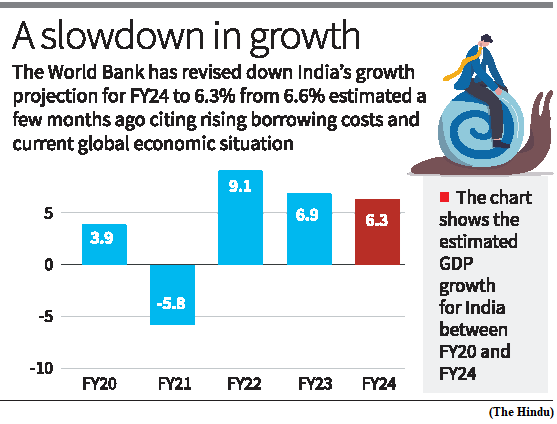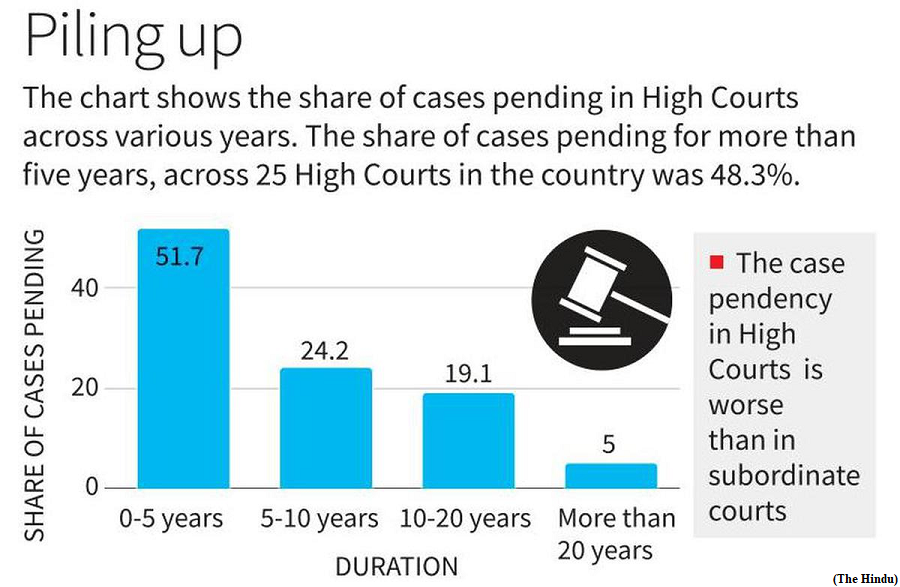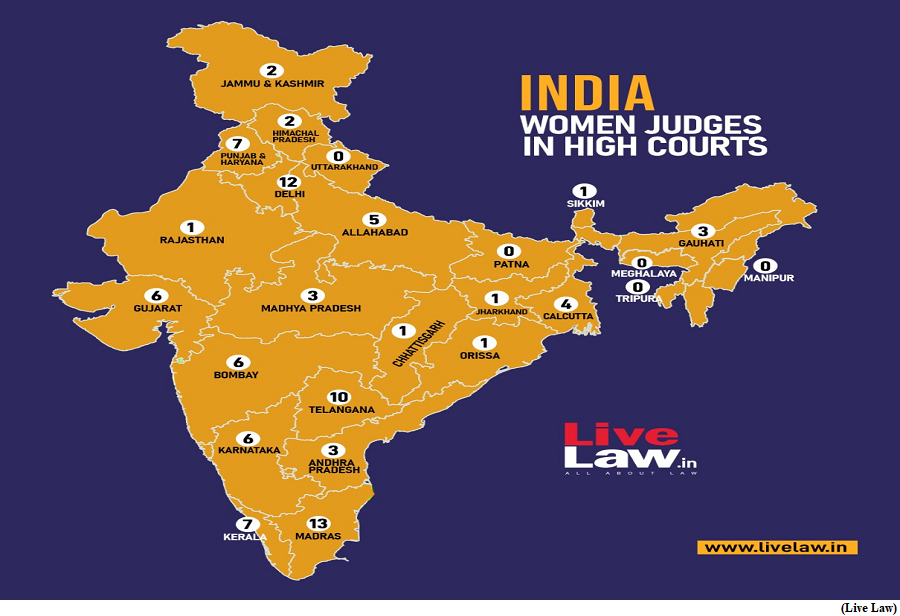World Bank lowers India’s growth forecast to 6.3% (GS Paper 3, Economy)

Why in news?
- Recently, the World Bank released its, ‘South Asia Economic Focus: Expanding Opportunities: Toward Inclusive Growth’ report.
Key Highlights:
- The World Bank has forecast a 6.3% economic growth rate for India in the current fiscal year, which ends March 31, 2024, a downgrade of 0.7 percentage points since its October forecast.
- The Indian economy is expected to grow at 6.4% in FY 2024-25, an upgrade of 0.3 percentage points from the previous forecast.
- The primary reasons for this are high borrowing costs and slower income growth causing weaker consumption, as well as the government tightening fiscal expenditure.
- The South Asia region as a whole is expected to grow at 5.6% this calendar year.
- While India fared better than the rest of the South Asian region, two major concerns were the female labour participation rate, which had dropped to below 20% and the informal sector neither becoming more productive nor shrinking.
Sri Lanka & Pakistan:
- The outlook for India’s neighbours Sri Lanka and Pakistan was bleaker. The World Bank forecast for Sri Lanka this calendar year was -4.3% (i.e., a contraction) and for Pakistan was 0.4% for the year ending June 30, 2023.
- The political uncertainty in Pakistan made making decisive reforms harder and it was important to have wide buy-in for the “reform process”.
- Pakistan is negotiating the release of a $1.1 billion tranche of a larger $6.5 billion bailout package with the International Monetary Fund (IMF), which has been delayed.
- Sri Lanka, which faced economic collapse last year, negotiated a $3 billion loan from the IMF at the end of March and is hoping to secure further financing from international institutions.
Vacancies of judges remain high, cases pile up: India Justice Report
(GS Paper 2, Judiciary)
Why in news?
- According to the latest, India Justice Report (IJR), 2022, Indian courts are jammed with cases and are seeing pendency increase by the day.
- At the same time, they are also functioning with fewer judges than the sanctioned number.

Rising pendency:
- As of December 2022, against a sanctioned strength of 1,108 judges, the High Courts were functioning with only 778 judges. The subordinate courts were found functioning with 19,288 judges against a sanctioned strength of 24,631 judges.
- Correspondingly, the number of cases pending per judge is rising in most States over the past five years, while the sanctioned strength has remained more or less the same.
- At High Court level, Uttar Pradesh has the highest average pendency; cases remain pending for an average of 11.34 years, and in West Bengal for 9.9 years. The lowest average High Court pendency is in Tripura (1 year), Sikkim (1.9 years) and Meghalaya (2.1 years).
- The number of cases a judge has to deal with has steadily increased. Between 2018 and 2022, the caseload per judge increased in 22 States and Union Territories.
CCR:
India Justice Report:
- The India Justice Report is a collaborative effort undertaken in partnership with DAKSH, Commonwealth Human Rights Initiative, Common Cause, Centre for Social Justice, Vidhi Centre for Legal Policy and TISS-Prayas.
More women judges at districts courts than in High Courts
(GS Paper 2, Judiciary)
Why in news?
- There are more women judges at the district court level than at the High Court level, with 35% of the total number of judges at the district court level and only 13% of judges in the High Courts across the country being women, the India Justice Report (IJR), 2022 has revealed.

Key Highlights:
- While the share of women judges remains uneven across the States, Goa, with 70%, has the highest percentage of women judges at subordinate courts, followed by Meghalaya and Nagaland at 63% each.
- The IJR stated that the representation of women judges is steadily rising in subordinate courts, but in the High Courts, the share of women judges remains low.
High Courts:
- Among the High Courts, Sikkim, with a total strength of just three judges, has the highest national average at 33.3% of women judges.
- Meanwhile, Bihar, Tripura, Manipur, Meghalaya, and Uttarakhand continued to have no women judges in their High Courts.
Reservation:
- Though caste-based reservations vary from State to State, at the district court level, no State or Union Territory “could fully meet all its Scheduled Castes, Scheduled Tribes, and Other Backward Classes quotas”.
- A Department of Justice Report to the Parliamentary Standing Committee on Personnel, Public Grievances, Law and Justice is reported to have stated that “from 2018 to December 2022, a total of 537 judges were appointed to the High Courts, of whom 1.3% were ST, 2.8% SC, 11% were from OBC category and 2.6% were from minority communities”.
SLINEX-23
(GS Paper 3, Defence)
Why in news?

Key Highlights:
- The exercise is being conducted in two phases: the Harbour Phase from 03-05 April 2023, followed by a Sea Phase from 06-08 April 2023.
- Indian Navy is being represented by INS Kiltan, an indigenous Kamorta class ASW corvette and INS Savitri, an Offshore Patrol Vessel.
- The Sri Lanka Navy is being represented by SLNS Gajabahu and SLNS Sagara. Maritime Patrol Aircraft, helicopters and Special Forces from both the sides would also participate in the exercise.
Background:
Way Forward:
- SLINEX aims at enhancing interoperability, improving mutual understanding and exchanging best practices while jointly undertaking multi-faceted maritime operations.





